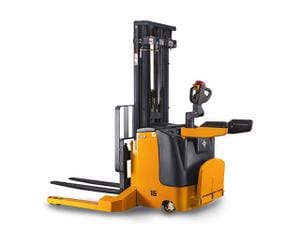Walkie Stacker Forklifts: Types, Safety, and Applications
Posted by: admin on April 24, 2025

Walkie stacker forklifts have revolutionized material handling for industries requiring tight-space solutions. Instead of riding atop a full-sized forklift, operators guide these compact machines from the ground, increasing maneuverability and reducing the learning curve. Completing proper walkie stacker training helps businesses maintain OSHA compliance while boosting warehouse safety and efficiency.
What Is a Walkie Stacker Forklift?
Walkie stacker forklifts are electric-powered pallet-moving devices that lift and transport loads without the bulk of a traditional forklift. Operators either walk behind or stand on the stacker, steering it with intuitive controls. These machines work best indoors on smooth surfaces where space is limited. Walkie forklifts differ from standard forklifts by offering a lower load capacity but greater ease of use in confined environments.
Walkie Stacker Forklift Safety Tips
Walkie stackers require the same attention to safety as larger lifts. Operators should:
- Complete OSHA-compliant training tailored to walkie stackers.
- Maintain slower speeds in crowded warehouse aisles.
- Always inspect battery charge, brakes, and forks before starting a shift.
- Stay clear of other pedestrians and signal turns in advance.
Following walkie stacker safety protocols protects workers, goods, and equipment.
Walkie Stacker vs. Forklift: Which Is Better?
Each machine fits specific applications:
- Walkie Stacker Advantages: Smaller footprint, easier handling, lower operating costs.
- Forklift Advantages: Higher lift heights, outdoor usability, and heavier load capacities.
Warehouses with limited aisle space benefit from walkie stackers, while industries requiring rugged lifting power may prefer forklifts.
Types of Walkie Stackers and Their Benefits
Walkie Straddle Stacker
Built for close-quarter pallet work, walkie straddle stackers feature stabilizing arms that straddle the pallet, maximizing balance without sacrificing mobility.
Walkie Reach Stacker
Equipped with a scissor mast, walkie reach stackers extend forward, allowing operators to place loads onto trucks or into deep shelving without repositioning.
Ride-On Walkie Stacker
Operators ride aboard these stackers, increasing travel speeds across larger warehouse floors. They combine walkie maneuverability with operator convenience.
Counter-Balance Walkie Stacker
Counter-balance models eliminate stabilizing arms, relying on rear weights to maintain center of gravity. They excel in areas where straddling pallets is impractical.
Standard Walkie Stacker
Basic walkie stackers deliver efficient, affordable pallet lifting for light to moderate warehouse duties. They serve as a simple upgrade from manual pallet jacks.
Applications of Walkie Stackers
Walkie stackers suit a variety of environments:
- Retail Warehouses: For organizing high-density product shelves.
- Distribution Centers: To move shipments efficiently without crowding work areas.
- Manufacturing Plants: For transporting parts and equipment between production lines.
Thanks to their versatility, walkie stackers even assist in home improvement stores and specialty storage facilities.
FAQs About Walkie Stackers
Do You Need Certification to Operate a Walkie Stacker?
Yes. OSHA requires formal instruction and hands-on evaluation for all powered industrial truck operators, including walkie stackers.
What Safety Standards Apply to Walkie Forklifts?
Operators must follow OSHA 29 CFR 1910.178 regulations, covering training, maintenance, and operation.
How Does a Walkie Straddle Stacker Differ from Other Stackers?
Walkie straddle stackers distribute weight evenly using legs that pass around the pallet. This feature allows for tighter turning radii and better stability in small workspaces.
Train Your Team with CertifyMe
CertifyMe delivers OSHA-compliant walkie stacker forklift certification through convenient online courses. In less than one hour, employees gain critical knowledge to handle walkie forklifts safely and efficiently. Empower your team to meet regulatory standards and maximize workplace safety today with CertifyMe’s trusted training programs.
Welcome to CertifyMe.net
CertifyMe.net has offered online forklift certification since 1999. With Our Convenient online program. your employess can earn their certification in an hour or less.
Browse Online Certifications:
This low-cost program can be compeleted anytime, anywhere!






